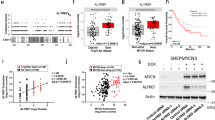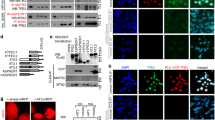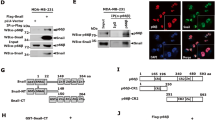Abstract
Vimentin exhibits a complex pattern of developmental- and tissue-specific expression and is aberrantly expressed in most metastatic tumors. The human vimentin promoter contains multiple DNA elements, some of which enhance gene expression and one that inhibits. A silencer element (at −319) binds the repressor ZBP-89. Further upstream (at −757) is an element, which acts positively in the presence of the silencer element and, thus, is referred to as an antisilencer (ASE). Previously, we showed that Stat1α binds to this element upon induction by IFN-γ. However, substantial binding and reporter gene activity was still present in nontreated cells. Here, we have found that Stat3 binds to the ASE element in vitro. Transfection experiments in COS-1 cells with various vimentin promoter–-reporter constructs show that gene activity is dependent upon the cotransfection and activation of Stat3. Moreover, activated Stat3 can overcome ZBP-89 repression. Coimmunoprecipitation studies demonstrate that Stat3 and ZBP-89 can interact and confocal microscopy detects these factors to be colocalized in the nucleus. Moreover, a correlation exists between the presence of activated Stat3 and vimentin expression in MDA-MB-231 cells, which is lacking in MCF7 cells where vimentin is not expressed. In the light of these results, we propose that the interaction of Stat3 and ZBP-89 may be crucial for overcoming the effects of the repressor ZBP-89, which suggests a novel mode for Stat3 gene activation.
This is a preview of subscription content, access via your institution
Access options
Subscribe to this journal
Receive 50 print issues and online access
$259.00 per year
only $5.18 per issue
Buy this article
- Purchase on Springer Link
- Instant access to full article PDF
Prices may be subject to local taxes which are calculated during checkout






Similar content being viewed by others
References
Bai L and Merchant JL . (2000). J. Biol. Chem., 275, 30725–30733.
Bai L and Merchant JL. . (2001). Mol. Cell. Biol., 21, 4670–4683.
Bowman T, Garcia R, Turkson J and Jove R . (2000). Oncogene, 19, 2474–2488.
Bromberg JF . (2001). BioEssays, 23, 161–169.
Bromberg JF, Wrzeszczynsk MH, Devgan G, Zhao Y, Pestell RG, Albanese C and Darnell JE . (1999). Cell, 98, 295–303.
Bussemakers MJ, Verhaegh GW, vanBokhoven A, Debruyne FM and Schalken JA . (1992). Biochem. Biophys. Res. Commun., 182, 1254–1259.
Carey I and Zehner ZE . (1995). Cell Growth Differ., 6, 899–908.
Chen JH, Vercamer C, Li Z, Paulin D, Vandenbunder B and Stehelin D . (1996). Oncogene, 13, 1667–1675.
Cheng PY, Kagawa N, Takahashi Y and Waterman MR . (2000). Biochemistry, 39, 4347–4357.
Darnell JE . (1997). Science, 277, 1630–1635.
Dignam JD, Lebowitz RM and Roeder RG . (1983). Nucleic Acids Res., 11, 1475–1489.
Dobretsova A and Wight PA . (1999). J. Neurochem., 72, 2227–2237.
Duprey P and Paulin D . (1995). Int. J. Dev. Biol., 39, 443–457.
Emili A, Greenblatt J and Ingles CJ . (1994). Mol. Cell. Biol., 14, 1582–1593.
Franke WW, Schmid E, Winter W, Osborn M and Weber K . (1979). Exp. Cell Res., 123, 25–48.
Garcia R, Bowman TL, Niu G, Yu H, Minton S, Muro-Cacho CA, Cox CE, Falcone R, Fairclough R, Parsons S, Laudano A, Gazit A, Levitzki A, Kraker A and Jove R . (2001). Oncogene, 20, 2499–2513.
Gilles C and Thompson EW . (1996). Breast J., 2, 83–96.
Gilles C, Polette M, Mestdagt M, Nawrocki-Raby B, Ruggeri P, Birembaut P and Foidart J-M . (2003). Cancer Res., 63, 2658–2664.
Hasegawa T, Takeuchi A, Miyaishi O, Isobe KI and deCrombrugghe B . (1997). J. Biol. Chem., 272, 4915–4923.
Hasegawa T, Xiao H and Isobe KI . (1999). Biochem. Biophys. Res. Commun., 256, 249–254.
Horvath CM . (2000). Trends Biochem. Sci., 25, 496–502.
Hsieh TC, Xu W and Chiao JW . (1995). Exp. Cell Res., 8, 137–143.
Ihle JN . (1996). Cell, 84, 331–334.
Izmailova ES, Snyder SR and Zehner ZE . (2000). J. Interf. Cytok. Res., 20, 13–20.
Izmailova ES, Wieczorek E, Perkins EB and Zehner ZE . (1999). Gene, 235, 69–75.
Izmailova ES and Zehner ZE . (1999). Gene, 230, 111–120.
Keates AC, Keates S, Kwon JH, Arseneau KO, Law DJ, Bai L, Merchant JL, Wang TC and Kelly CP . (2001). J. Biol. Chem., 276, 43713–43722.
Law DJ, Tarle SA and Merchant JL . (1998a). Mamm. Genome, 9, 165–167.
Law GL, Itoh H, Law DJ, Mize GJ, Merchant JL and Morris DR . (1998b). J. Biol. Chem., 273, 19955–19964.
Levy DE and Darnell JE . (2002). Nat. Rev. Mol. Cell Biol., 3, 651–662.
Lilienbaum A and Paulin D . (1993). J. Biol. Chem., 268, 2180–2188.
Lim CP and Cao X . (2001). J. Biol. Chem., 276, 21004–21011.
Malone C, Gangadharan D, Omori SA and Wall R . (2001). Gene, 268, 9–16.
Merchant JL, Iyer GR, Taylor BR, Kitchen JR, Mortensen ER, Wang Z, Flintoft RJ, Michel JB and Bassel-Duby R . (1996). Mol. Cell. Biochem., 16, 6644–6653.
Meyer T, Gavenis K and Vinkemeier U . (2002). Exp. Cell Res., 272, 45–55.
Nielsen DA, Chou J, MacKrell AJ, Casadaban MJ and Steiner DF . (1983). Proc. Natl. Acad. Sci. USA, 80, 5198–5202.
Parry DA and Steinert PM . (1992). Curr. Opin. Cell Biol., 4, 94–98.
Passantino R, Antona V, Barbieri G, Rubino P, Melchionna R, Cossu G, Feo S and Giallongo A . (1998). J. Biol. Chem., 273, 484–494.
Quandt K, Frech K, Karas H, Wingender E and Werner T . (1995). Nucleic Acids Res., 23, 4878–4884.
Remington MC, Tarle SA, Simon B and Merchant JL . (1997). Biochem. Biophys. Res. Commun., 237, 230–234.
Rinehart-Kim J, Johnston M, Birrer M and Bos T . (2000). Int. J. Cancer, 88, 180–190.
Rittling SR and Baserga R . (1987). Mol. Cell. Biochem., 7, 3908–3915.
Rittling SR, Coutinho L, Amram T and Kolbe M . (1989). Nucleic Acids Res., 17, 1619–1633.
Salvetti A, Lilienbaum A, Li Z, Paulin D and Gazzolo L . (1993). Mol. Cell. Biol., 13, 89–97.
Schindler C and Darnell JE . (1995). Annu. Rev. Biochem., 64, 621–651.
Sehgal PB . (2000). Cell Signal., 12, 525–535.
Seed B and Sheen JY . (1988). Gene, 67, 271–277.
Seto E, Lewis B and Shenk T . (1993). Nature, 365, 462–464.
Smith LM, Wise SC, Hendricks DT, Sabichi AL, Bos T, Reddy P, Brown PH and Birrer MJ . (1999). Oncogene, 18, 6063–6070.
Sommers CL, Heckford SE, Skerker JM, Worland P, Torri JA, Thompson EW, Byers SW and Gelmann EP . (1992). Cancer Res., 52, 190–197.
Sommers CL, Walker-Jones D, Heckford SE, Worland P, Valverius E, Clark R, McCormick F, Stampfer M, Abularach S and Gelmann EP . (1989). Cancer Res., 49, 4258–4263.
Steinert PM and Liem RK . (1990). Cell, 60, 521–523.
Stover DM and Zehner ZE . (1992). Mol. Cell. Biol., 12, 2230–2240.
Turkson J, Bowman T, Garcia R, Caldenhoven E, DeGroot RP and Jove R . (1998). Mol. Cell. Biol., 18, 2545–2552.
Wang Y, Kobori JA and Hood L . (1993). Mol. Cell. Biol., 13, 5691–5701.
Wieczorek E, Lin Z, Perkins EB, Law DJ, Merchant JL and Zehner ZE . (2000). J. Biol. Chem., 275, 12879–12888.
Wu Y, Zhang X and Zehner ZE . (2003). Oncogene, 22, 8891–8901.
Yamada A, Takaki S, Hayashi F, Georgopoulos K, Perlmutter RM and Takatsu K . (2001). J. Biol. Chem., 276, 18082–18089.
Ye S, Whatling C, Watkins H and Henney A . (1999). FEBS Lett., 450, 268–272.
Yoo JY, Wang W, Desiderio S and Nathans D . (2001). J. Biol. Chem., 276, 26421–26429.
Zajchowski DA, Bartholdi MF, Gong Y, Webster L, Liu HL, Munishkin A, Beauheim C, Harvey S, Ethier SP and Johnson PH . (2001). Cancer Res., 61, 5168–5178.
Zhang X, Diab I and Zehner ZE . (2003). Nucleic Acids Res., 31 (11), 2900–2914.
Zhang X, Wrzeszczynska MH, Horvath CM and Darnell JE . (1999). Mol. Cell. Biol., 19, 7138–7146.
Acknowledgements
We thank Dr Juanita Merchant for the gift of the Flag-tagged-pCMV-ZBP-89 expression plasmid and Dr James Darnell for the gift of the pRcCMV-Stat3 expression plasmid. This work was supported by NHLBI, National Institutes of Health (NIH) Grant HL-45422 to ZEZ.
Author information
Authors and Affiliations
Corresponding author
Rights and permissions
About this article
Cite this article
Wu, Y., Diab, I., Zhang, X. et al. Stat3 enhances vimentin gene expression by binding to the antisilencer element and interacting with the repressor protein, ZBP-89. Oncogene 23, 168–178 (2004). https://doi.org/10.1038/sj.onc.1207003
Received:
Revised:
Accepted:
Published:
Issue Date:
DOI: https://doi.org/10.1038/sj.onc.1207003
Keywords
This article is cited by
-
Unraveling the complexity of STAT3 in cancer: molecular understanding and drug discovery
Journal of Experimental & Clinical Cancer Research (2024)
-
STAT3/LKB1 controls metastatic prostate cancer by regulating mTORC1/CREB pathway
Molecular Cancer (2023)
-
Overexpression of Stat3 increases circulating cfDNA in breast cancer
Breast Cancer Research and Treatment (2021)
-
Beyond just a tight fortress: contribution of stroma to epithelial-mesenchymal transition in pancreatic cancer
Signal Transduction and Targeted Therapy (2020)
-
Enterovirus A71 capsid protein VP1 increases blood–brain barrier permeability and virus receptor vimentin on the brain endothelial cells
Journal of NeuroVirology (2020)



